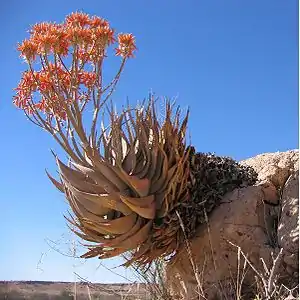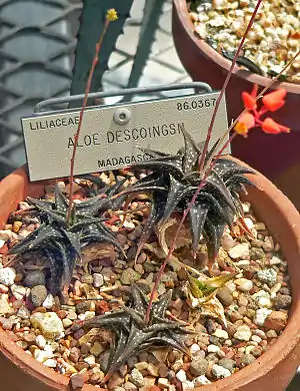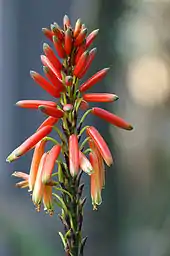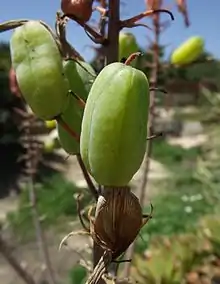Aloen
Die Aloen (Aloe) sind eine Pflanzengattung aus der Unterfamilie der Affodillgewächse (Asphodeloideae). Zur Gattung gehören über 500 Arten.
| Aloen | ||||||||||||
|---|---|---|---|---|---|---|---|---|---|---|---|---|

Aloe hereroensis | ||||||||||||
| Systematik | ||||||||||||
| ||||||||||||
| Wissenschaftlicher Name | ||||||||||||
| Aloe | ||||||||||||
| L. |


Beschreibung
Vegetative Merkmale
Die Aloe-Arten sind ausdauernde, blattsukkulente Pflanzen. Sie wachsen stammlos, strauchig oder baumförmig. Der Stamm kann einfach oder verzweigt sein. Ihre stängelumfassenden Laubblätter stehen rosettig, zweizeilig oder sind zerstreut um die Sprossachse angeordnet.
Die Form der Blätter ist für gewöhnlich mehr oder weniger dreieckig, lanzettlich oder sichelförmig und manchmal linealisch. Der Blattrand ist meist mit weichen oder stechenden, dreieckigen Zähnen versehen, die für gewöhnlich nahe dem Spreitengrund dichter gedrängt stehen. Die einheitliche gefärbte oder mit weißlichen oder hellgrünen Flecken bedeckte Oberfläche der Blätter ist kahl oder manchmal mit kurzen Stacheln besetzt. Die Blätter sind nur selten faserig. Bei Verletzung der Blätter tritt meist ein bitterer gelber oder brauner Saft aus.
Blütenstände und Blüten
_male_on_Aloe_flowers_(30216015541).jpg.webp)
Der meist mehr oder weniger aufrechte Blütenstand erscheint seitlich, ist einfach oder verzweigt und besteht aus zylindrischen oder kopfigen, traubigen Teilblütenständen, mit manchmal einseitswendigen Blüten. Die zygomorphen Blüten sind gestielt und mit Tragblättern versehen. Sie sind nur selten sitzend. Zur Fruchtreife ist der Blütenstiel oft verlängert. Der Blütenboden ist gerundet, gestutzt oder verschmälert. Die für gewöhnlich roten oder gelben, selten weißen, kahlen, selten flaumhaarigen Blüten sind an der Basis zylindrisch, werden dann meist dreikantig. Sie sind seitlich leicht zusammengedrückt und für gewöhnlich gebogen. Die Blüten sind vormännlich. Die drei äußeren Tepalen sind meist an der Basis am Rand verwachsen, die Spitzen sind freistehend. Die inneren drei Tepalen sind an den Rändern meist freistehend, aber rückenwärts (dorsal) mit der äußeren Blütenröhre verbunden. Es sind sechs Staubblätter vorhanden. Die Staubbeutel sind für gewöhnlich teilweise herausragend oder überragen die Blütenhülle um 1 bis 6 Millimeter. Der einfache Griffel besitzt eine kopfige Narbe.
Die Blüten der meisten Aloen werden durch Vögel bestäubt (Ornithophilie). Dabei dient die Anpassung an unterschiedliche Vogelarten als Hybridisierungsschranke zwischen unterschiedlichen Aloearten. Arten mit wenig konzentriertem Nektar in langen Kronröhren werden hauptsächlich durch langschnäbelige Nektarvögel (Nectariniidae) bestäubt. Aloearten mit kürzeren Kronröhren und wasserreichem Nektar werden durch weniger spezialisierte Vögel mit kürzeren Schnäbeln bestäubt. Aloearten, die gemeinsame Bestäuber haben, blühen dagegen meist zu unterschiedlichen Zeiten.[1] Einige wenige Aloearten mit kurzschäftigen weißlichen oder cremefarbenen Blüten wie Aloe inconspicua, Aloe minima und Aloe linearifolia werden vorwiegend durch Insekten bestäubt.[2]
Früchte und Samen
Die Früchte sind meist Kapseln oder manchmal Beeren. Sie enthalten kantige oder abgeflachte, schwarze oder braune Samen mit meist schmalen, häutigen Flügeln.
 Früchte von Aloe fosteri
Früchte von Aloe fosteri.jpg.webp) Samen von drei Aloearten
Samen von drei Aloearten
Genetik
Die Chromosomengrundzahl beträgt x = 7.
Systematik und Verbreitung
Die Gattung Aloe ist hauptsächlich im Süden und Osten Afrikas und auf vorgelagerten Inseln wie Madagaskar und Maskarenen sowie im Südwesten der Arabischen Halbinsel verbreitet. Drei Arten (Aloe buettneri, Aloe macrocarpa und Aloe schweinfurthii) sind in Westafrika zu finden.
Die wissenschaftliche Erstbeschreibung wurde 1753 von Carl von Linné vorgenommen.[3] Folgende Arten und Hybriden gehören zur Gattung Aloe:
Aufgrund neuerer phylogenetischer Untersuchungen schlugen Olwen Megan Grace und Mitarbeiter Anfang 2013 verschiedene taxonomische Änderungen vor. Die Arten der Gattung Chortolirion werden in die Gattung Aloe einbezogen, Aloe plicatilis wird in die monotypische Gattung Kumara Medik. (1786) zurückverwiesen. Die Autoren schlagen zwei neue Gattungen vor: Aloidendron (A.Berger) Klopper & Gideon F.Sm. und Aloiampelos Klopper & Gideon F.Sm.. In die neue Gattung Aloidendron werden sechs baumförmige Aloen eingeordnet: Aloe barberae, Aloe dichotoma, Aloe eminens, Aloe pillansii, Aloe ramosissima und Aloe tongaensis. Die neue Gattung Aloiampelos umfasst die sieben hauptsächlich kletternde Aloen Aloe ciliaris, Aloe commixta, Aloe decumbens, Aloe gracilis, Aloe juddii, Aloe striatula und Aloe tenuior.[4]
- Hybriden
Folgende Hybriden innerhalb der Gattung Aloe (infragenerischen Hybriden) sind bekannt:
- Aloe × abhaica
Aloe pseudorubroviolacea × Aloe edentata - Aloe × anosyana[N 49]
Aloe vaotsohy × Aloe helenae - Aloe × buzairiensis[N 50]
Aloe perryi × Aloe squarrosa - Aloe × imerinensis
Aloe capitata × Aloe macroclada - Aloe × keayi
Aloe buettneri × Aloe schweinfurthii - Aloe × qaharensis
Aloe fleurentiniorum × Aloe woodii
Verschiedene Arten der Gattung Aloe sind an Gattungshybriden (intergenerischen Hybriden) beteiligt:
- ×Algastoloba D.M.Cumming
= Aloe × Astroloba × Gasteria - ×Alolirion G.D.Rowley
= Aloe × Chortolirion - ×Aloloba G.D.Rowley
= Aloe × Astroloba - ×Alworthia G.D.Rowley
= Aloe × Haworthia - ×Bayerara D.M.Cumming
= Aloe × Gasteria × Haworthia - ×Gasteraloe Guillaumin
= Aloe × Gasteria
- Synonyme
Synonyme der Gattung sind Kumara Medik. (1786), Lomatophyllum Willd. (1811), Rhipidodendrum Spreng. (1811), Phylloma Ker Gawl. (1813), Rhipidodendrum Willd. (1817, nom. inval. ICBN-Artikel 61.1), Pachidendron Haw. (1821), Bowiea Haw. (1827, nomen rejectum), Pachidendron Dumort. (1829, nom. inval. ICBN-Artikel 61.1), Agriodendron Endl. (1836), Succosaria Raf. (1840), Ariodendron Meisn. (1842), Busipho Salisb. (1866), Ptyas Salisb. (1866), Chamaealoe A.Berger (1905), × Lomataloe Guillaumin (1931), Leptaloe Stapf (1933), Guillauminia A.Bertrand (1956) und Lemeea P.V.Heath (1993).
Gefährdung
Mit Ausnahme von Aloe vera wurden alle Aloe-Arten in den Anhang II des Washingtoner Artenschutz-Übereinkommens aufgenommen. Zusätzlich durch die Aufnahme in den Anhang I geschützt sind Aloe albida, Aloe albiflora, Aloe alfredii, Aloe bakeri, Aloe bellatula, Aloe calcairophila, Aloe compressa (einschließlich Aloe compressa var. paucituberculata, Aloe compressa var. rugosquamosa und Aloe compressa var. schistophila), Aloe delphinensis, Aloe descoingsii, Aloe fragilis, Aloe haworthioides (einschließlich Aloe haworthioides var. aurantiaca), Aloe helenae, Aloe laeta, (einschließlich Aloe laeta var. maniaensis), Aloe parallelifolia, Aloe parvula, Aloe pillansii, Aloe polyphylla, Aloe rauhii, Aloe suzannae, Aloe versicolor und Aloe vossii.[5]
Nachweise
Literatur
- Alwin Berger: Aloe. In: Adolf Engler (Hrsg.): Das Pflanzenreich. Regni vegetablilis conspectus. Heft 33: Liliaceae-Asphodeloideae-Aloineae, Wilhelm Engelmann, Leipzig 1908, S. 159–326 (online).
- Estrela Figueiredo, Gideon F. Smith: What’s in a name: epithets in Aloe L. (Asphodelaceae) and what to call the next new species. In: Bradleya. Band 28, 2010, S. 79–102.
- Walter C. Holmes, Heather L. White: Aloe. In: Flora of North America, Band 26, S. 410 (online).
- Leonard Eric Newton: Aloe. In: Urs Eggli (Hrsg.): Sukkulenten-Lexikon. Einkeimblättrige Pflanzen (Monocotyledonen). Eugen Ulmer, Stuttgart 2001, ISBN 3-8001-3662-7, S. 104–193.
- Gideon F. Smith, Colin C. Walker, Estrela Figueiredo: What’s in a name: an update on epithets used in Aloe L. (Asphodelaceae). In: Bradleya. Band 29, 2011, S. 179–181 (PDF).
Einzelnachweise
- Christo Botes, Steven D. Johnson, Richard M. Cowling: Coexistence of succulent tree aloes: partitioning of bird pollinators by floral traits and flowering phenology. In: Oikos. Band 117, Nummer 6, 2008, S. 875–882, doi:10.1111/j.0030-1299.2008.16391.x.
- C. Botes, P.D. Wragg, S.D. Johnson: New evidence for bee-pollination systems in Aloe (Asphodelaceae: Aloideae), a predominantly bird-pollinated genus. In: South African Journal of Botany. Band 75, Nummer 4, 2009, S. 675–681, DOI:10.1016/j.sajb.2009.07.010.
- Species Plantarum. Band 1, S. 319, 1753; online
- Olwen Megan Grace, Ronell R. Klopper, Gideon F. Smith, Neil R. Crouch, Estrela Figueiredo, Nina Ronsted, Abraham E. van Wyk: A revised generic classification for Aloe (Xanthorrhoeaceae subfam. Asphodeloideae). In: Phytotaxa. Band 76, Nummer 1, 2013, S. 7–14 (doi:10.11646/phytotaxa.76.1.1).
- Appendices I, II and III valid from 3 April 2012. (abgerufen am 10. August 2012).
Erstbeschreibungen seit 2009
- J.-B.Castillon: In: International Cactus Adventures. Nummer 83, 2009, S. 30–31.
- Rokiman Letsara, Solofo Rakotoarisoa, Frank Almeda: Three new Aloe species from Madagascar. In: Malagasy Nature. Band 6, 2012, S. 46–55 (PDF).
- T. A. McCoy, J. Lavranos: Two new additions to the genus Aloe from Somalia. In: Cactus World. Band 33, Nummer 3, 2015, S. 179–184.
- J.-B.Castillon: In: International Cactus Adventures. Nummer 83, 2009, S. 31.
- Jean-Bernard Castillon: Two new Aloe taxa (Asphodelaceae) from the vicinity of the town of Ambatofinandrahana, Madagascar. In: CactusWorld. Band 29, Nummer 1, 2011, S. 51–55.
- Tom A. McCoy: Eine beachtenswerte neue Aloe-Art aus Südsudan. In: Avonia. Band 34, Nummer 4, 2016, S. 196–201.
- Sebsebe Demissew, Ib Friis, Tesfaye Awas, Paul Wilkin, Odile Weber, Steve Bachman, Inger Nordal: Four new species of Aloe (Aloaceae) from Ethiopia, with notes on the ethics of describing new taxa from foreign countries. In: Kew Bulletin. Band 66, Nummer 1, 2011, S. 111–121 (doi:10.1007/s12225-011-9263-2).
- Jean-Bernard Castillon: Aloe bernardii, un Aloe nouveau de la région d’Ikalamavony. In: Cactus Aventures International. Nummer 89, 2011, S. 25–27.
- Gideon F. Smith, Estrela Figueiredo, Ronell R. Klopper, Neil. R. Crouch: Summer-flowering species of maculate Aloe L. (Asphodelaceae: Alooideae) in the Aloe zebrina-complex from South Africa: reinstatement of four names, and description of A. braamvanwykii Gideon F.Sm. & Figueiredo. In: Bradleya. Band 30, 2012, S. 162.
- Thomas C Cole, Thomas G Forrest: Two New Aloe Species From Uganda. In: Cactus and Succulent Journal. Band 83, Nummer 1, Cactus and Succulent Society of America, 2011, S. 28–38 (doi:10.2985/0007-9367-83.1.28).
- J.-P.Castillon: In: International Cactus Adventures. Nummer 81, 2009, S. 12–15.
- Ernst J. van Jaarsveld: Aloe condyae, a new cliff-dwelling aloe from Mpumalanga, Republic of South Africa. In: Bradleya. Band 30, 2012, S. 169.
- Jean-Philippe Castillon: A new small Aloe (Asphodelaceae) from the north-eastern coast of Madagascar. In: CactusWorld. Band 27, Nummer 3, 2009, S. 177–179.
- Norbert Rebmann: In: International Cactus Adventures. Nummer 84, 2009, S. 29.
- Norbert Rebmann: In: International Cactus Adventures. S. 84, 2009, S. 30.
- J.-B.Castillon: In: International Cactus Adventures. Nummer 85, 2010, S. 7.
- Norbert Rebmann: In: International Cactus Adventures. Nummer 82, 2009, S. 2–6.
- R. R. Klopper, G. F. Smith: Asphodelaceae: Alooideae. Aloe hahnii, a new species in the section Pictae, in the Soutpansberg Centre of Endemism, Limpopo Province, South Africa. In: Bothalia. Band 39, Nummer 1, 2009, S. 98–100.
- Ernst J. van Jaarsveld, Wessel Swanepoel: Aloe huntleyana, a new species from the Baynes Mountains, Namibia. In: Bradleya. Band 30, 2012, S. 3.
- Maurizio Dioli: Aloe ikiorum: A new species from Uganda. In: Cactus and Succulent Journal. Band 83, Nummer 6, 2011, S. 270–274 (doi:10.2985/0007-9367-83.6.270).
- Roman Štarha and Petr Pavelka: Aloe iringaensis a New Species from Tanzania. In: Cactus and Succulent Journal. Band 92, Nummer 1, 2020, S. 16–19 (doi:10.2985/015.092.0103).
- Jean-Bernard Castillon: Aloe johannis-philippei, a new Aloe (Asphodelaceae) from the high mountains of central Madagascar. In: CactusWorld. Band 27, Nummer 1, 2009, S. 51–56.
- E. J. van Jaarsveld: Aloe kamnelii, a new cliff-dwelling species of Aloe section Aloe series Rhodacanthae from the Western Cape (South Africa). In: Aloe. Band 46, Nummer 2, 2009, S. 36–45.
- Aloe. Band 48, Nummer 3, 2011, S. 64–66.
- Sarel J. Marais: In: Aloe. Band 47, Nummer 4, 2010, S. 96–99.
- Gideon F. Smith, Estrela Figueiredo, Ronell R. Klopper, Neil R. Crouch: Aloe maculata All. (Asphodelaceae) in the Free State Province, South Africa, and resurrection of 'var. ficksburgensis'. In: Bradleya. Band 30, 2012, S. 15.
- Jean-Philippe Castillon: Two new species of Aloe (Asphodelaceae) from Madagaskar. In: CactusWorld. Band 30, Nummer 3, S. 163–169.
- J.-B.Castillon: In: International Cactus Adventures. Nummer 85, 2010, S. 2–5.
- Ernst J. van Jaarsveld: Aloe mocamedensis, a new species from the Namib Desert, south-western Angola. In: Bradleya. Band 30, 2012, S. 173.
- M. Uleh, L. E. Newton: A new varie-ty of Aloe morijensis S.Carter & Brandham in Kenya. In: Cactus World. Band 33, Nummer 2, 2015, S. 123–124.
- Anthon Ellert: Aloe mossurilensis Ellert sp. nov. A long-overlooked species from northern. Mocambique. In: Alsterworthia International. Band 8, Nummer 1, 2008, S. 24–28.
- Anthon Ellert: In: Alsterworthia International. Band 10, Nummer 1, 2010, S. 6.
- Jean-Bernard Castillon: A new Aloe (Asphodelaceae) from the area of Fort Dauphin, Madagascar. In: CactusWorld. Band 29, Nummer 4, 2011, S. 217–219.
- R. R. Klopper, G. F. Smith: Notes on African plants. Asphodelaceae: Alooideae. Aloe neilcrouchii, a new robust leptaloe from KwaZulu-Natal, South Africa. In: Bothalia. Band 40, Nummer 1, 2010, S. 93–96.
- Jean-Bernard Castillon: Rectification of a mistake by G.W.Reynolds on a Malagasy Aloe (Asphodelaceae) and description of a new species. In: Bradleya. Band 27, 2009, S. 152.
- Gideon F. Smith, N.R.Crouch: Aloe nicholsii GIDEON F. SM. & N. R. CORUCH (Asphodelaceae): a new leptoaloe from KwaZulu-Natal, South Africa. In Bradleya. Band 28, 2010, S. 103–106.
- L. E. Newton: A new species of Aloe in Tanzania with second flowers. In: Cactus World. Band 33, Nummer 1, 2015, S. 50–52.
- Mats Thulin: Aloe nugalensis sp. nov. (Asphodelaceae), a new gypsum endemic from northeastern Somalia. In: Nordic Journal of Botany. Band 30, Nummer 6, 2012, S. 729–731 (doi:10.1111/j.1756-1051.2011.01323.x).
- A. Ellert: Aloe perdita, a long-lost species from the Chimanimani Mountains on the. Zimbabwe/Mocambique border. In: Aloe. Band 45, Nummer 4, 2008, S. 76–77.
- J.-P.Castillon: In: International Cactus Adventures. Nummer 81, 2009, S. 18–19.
- Mary E. Barkworth, Ahmed Ibrahim Awale & Faisal Jama Gelle. 2019. Dacar Cas/Somali Red Aloe: A New Species of Aloe (Asphodelaceae) from Somaliland. PhytoKeys. 117: 85-97. DOI: 10.3897/phytokeys.117.28226
- Giuseppe Orlando, Marwan El Azzouni: A new, cliff-dwelling aloe from south-east Yemen. In: CactusWorld. Band 28, Nummer 4, 2010, S. 207–210.
- Neil R. Crouch, Gideon F. Smith: Aloe sharoniae N.R.Crouch & Gideon F.Sm. (Asphodelaceae): species rank for a leptoaloe from southern Africa. In: Bradleya. Band 29, 2011, S. 115–120, (PDF).
- Jean-Bernard Castillon: In: Cactus Aventures International. Nummer 90, 2011, S. 2–5.
- Leonard E. Newton: Two new species of Aloe in Kenya. In: Bradleya. Band 29, 2011, S. 57–60.
- Ernst Jacobus van Jaarsveld: Aloe tongaensis, a new species from Tongaland KwaZulu-Natal (South Africa), and a new sectional arrangement of the tree Aloe. In: Aloe. Band 47, Nummer 3, 2010, S. 4–11.
- Suresh Kumar, C.S. Purohit und Ravikiran N. Kulloli. 2020. Aloe trinervis sp. nov.: A New Succulent Species from Indian Desert (Asphodelaceae). Journal of Asia-Pacific Biodiversity. 13(2); 325-330. DOI: 10.1016/j.japb.2020.03.001
- T. A. McCoy, J. J. Lavranos: A new species from Aloe from the Sudan, and the answer to a long-standing mystery. In: Cactus World. Band 33, Nummer 1, 2015, S. 27–34.
- Jean-Philippe Castillon: Révision du groupe de l'Aloe divaricate Berger; correction d'une synonymie, combinaisons nouvelles et description d'un nouvel hybride. In: Adansonia. Band 34, Nummer 1, 2012, S. 13–21 (doi:10.5252/a2012n1a2).
- Joël Lodé: Description of a new Nothotaxon in the genus Aloe (Asphodelaceae) in Socotra: Aloe × buzairiensis J. Lodé nothosp. nov. In: Cactus Aventures International. Nummer 85, 2010
Weitere Literatur
- S. Carter, J. J. Lavranos, L. E. Newton, C. C. Walker: Aloes. The definitive guide. Kew Publishing, London 2011, ISBN 978-1-84246-439-7.
- Jean-Bernard Castillon: The Aloe of Madagascar. By the Author, 2010, ISBN 978-2-7466-1872-5.
- Charles Craib: Grass aloes in the South African veld. Umdaus Press, Hatfield 2005, ISBN 1-919766-40-5.
- Olwen Megan Grace: Contributions to the systematics and biocultural value of Aloe L. (Asphodelaceae). PhD thesis, University of Pretoria, Pretoria 2009 (online).
- Olwen Megan Grace, Ronell R. Klopper, Gideon F. Smith, Neil R. Crouch, Estrela Figueiredo, Nina Ronsted, Abraham E. van Wyk: A revised generic classification for Aloe (Xanthorrhoeaceae subfam. Asphodeloideae). In: Phytotaxa. Band 76, Nummer 1, 2013, S. 7–14 (doi:10.11646/phytotaxa.76.1.1).
- W. J. Jankowitz: Aloen von Südwestafrika. Abt. Naturschutz und Fremdenverkehr, Administration von Südwestafrika, Windhoek 1975.
- Eric Judd: What aloe is that? Purnell, Cape Town/Johannesburg 1967, ISBN 0-360-00013-4.
- Michael J. Kimberley: Succulent Plants of Zimbabwe and Their Conservation. Excelsa, Band 18, Aloe, Cactus, and Succulent Society of Zimbabwe, 1997.
- Ronell R. Klopper, S. Matos, Estrela Figueiredo, Gideon F. Smith: Aloe in Angola (Asphodelaceae: Alooideae). In: Bothalia. Band 39, Nummer 1, 2009, S. 19–35 (PDF).
- Ronell R. Klopper, Gideon F. Smith: The Genus Aloe L. (Asphodelaceae: Alooideae) in the Eastern Cape Province of South Africa. In: Haseltonia. Nummer 16, 2011, S. 16–53 (doi:10.2985/1070-0048-16.1.16).
- Stewart Lane: A field guide to the aloes of Malawi. Umdaus Press, Hatfield 2004, ISBN 1-919766-27-8.
- Jonas M. Lüthy: The Aloes and Euphorbias of CITES Appendix I & the genus Pachypodium. BVET, Bern 2006.
- Leonard E. Newton, Urs Eggli, Gordon D. Rowley: CITES Aloe and Pachypodium checklist. Royal Botanic Gardens, Kew, 2001, ISBN 1-84246-034-X (PDF, Update 2007).
- Gilbert Westacott Reynolds: The Aloes of South Africa. Aloes of South Africa Book Fund, Johannesburg 1950.
- Gilbert Westacott Reynolds: The Aloes of Nyasaland. Nyasaland Society and African Book Centre of Nyasaland, 1954.
- Gilbert Westacott Reynolds: The Aloes of tropical Africa and Madagascar. The Aloes Book Fund, Mbabane 1966.
- Gideon F. Smith, Braam Van Wyk: Aloes in Southern Africa. Struik, Cape Town 2008, ISBN 978-1-77007-462-0.
- Oliver West, Michael J. Kimberley: Aloes of Zimbabwe. 2. Auflage, Longman Zimbabwe, Harare 1992, ISBN 0-582-64163-2.
Weblinks
- Artenliste zu Aloe in der Red List of South African Plants